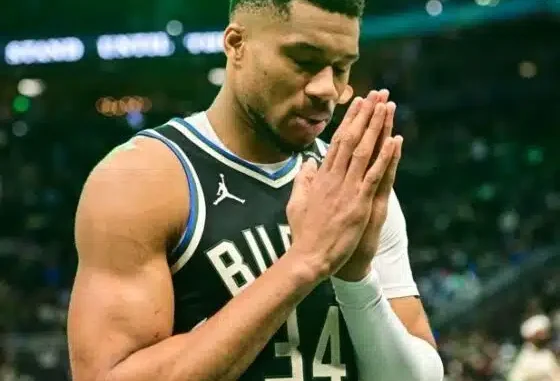
Contract broken: decision made! Milwaukee strong gladiator officially submit his wish amid trade persuasive_Giannis Antetokounmpo” who earned undisputed love affection from Bucks fans” officially end historic story…
Knicks’ Big Gamble: Doubts Over What It Really Would Cost to Land Giannis
For months, basketball observers have speculated that the New York Knicks were scheming their play to land Giannis Antetokounmpo — a move that would shock the NBA landscape, elevate expectations in New York, and reshape both the Eastern Conference and the Bucks. But in recent weeks, the narrative has begun to shift: the biggest obstacle to such a blockbuster may not be Milwaukee’s unwillingness to trade their superstar—but the Knicks’ own hesitancy over the cost, both in assets and long-term flexibility.
A window that never quite opened
The Knicks and Bucks reportedly held an “exclusive negotiating window” in August, during which New York attempted to float trade ideas around Giannis. But according to sources, that window closed without traction — not because Milwaukee accepted a lowball offer, but because New York’s proposals were never strong or convincing enough to move the conversation forward.
From Milwaukee’s side, the intent to hold onto Giannis remained firm. The franchise leadership reportedly conveyed that they “preferred not to move Antetokounmpo,” signaling that the Knicks’ offers didn’t even merit serious counteres. Meanwhile, league insiders believe that New York recognized early that it lacked the bargaining chips to match what Milwaukee would demand.
Thus, what seemed like a tantalizing possibility drifted into an understanding: the Knicks’ doubts—and asset constraints—may have been more decisive than even the Bucks’ resistance.
The asset drain: what New York has burned
One of the key constraints for the Knicks is that they’ve already spent much of their trade capital. In the past year, New York made aggressive moves: trading for Mikal Bridges and Karl-Anthony Towns, and extending Bridges into a long-term deal. Those maneuvers left their nonplayer assets — draft picks, swap rights, and otherwise flexible contracts — severely diminished.
Currently, the Knicks reportedly only hold one first-round pick (with protections), a few second-rounders, and some pick swaps — hardly enough ammunition to anchor a blockbuster with Giannis as the centerpiece. Moreover, several of their best tradeable players (Towns, Bridges, OG Anunoby) are on long, expensive contracts, which complicates packaging them in a deal without burdening Milwaukee with too much cap crunch.
That combination — limited sweeteners and heavy contracts — undermines New York’s leverage. Some mock proposals (such as a swap of Towns + Anunoby for Giannis + a throw-in) have circulated. But insiders understand these are more thought experiments than realistic blueprints.
Risk of overpaying for uncertainty
Even if New York could cobble together a package that enticed Milwaukee, the Knicks appear reluctant to cross certain internal red lines. The club must weigh the risk of mortgaging their future — including flexibility to adjust salary or roster as Giannis ages — against the upside of transforming into a title contender overnight. Some within the Knicks’ front office are said to be uneasy about pushing too much now, overcommitting premium assets and hindering future moves.
Complicating things further: Giannis is not exactly a selfless fit. His ball dominance, size, and free-throw usage demand complementary pieces, spacing, and defensive support. A former NBA player recently voiced skepticism about how well Giannis would mesh with the existing Knicks core of Jalen Brunson, Karl-Anthony Towns, and others. It’s not just about buying a star — it’s about assembling a supporting cast and preserving roster balance.
So the calculus isn’t just “Can we get Giannis?” but rather “At what cost — and what vulnerabilities are we creating?”
Giannis’ stance and Milwaukee’s faith
From Giannis’ perspective, New York was reportedly the one external destination he expressed personal interest in — if he ever left Milwaukee. But he’s not currently forcing a move. He’s publicly recommitted to the Bucks for now, though he has not categorically closed the door on future changes.
Milwaukee, meanwhile, is betting that stability and early-season success will quiet the rumblings. They’ve added pieces like Myles Turner to shore up their roster, signaling they believe they can still compete with Giannis at the helm. The front office, at the very least, wanted the Knicks’ offers to force meaningful negotiations. But sources say New York never got there.
What now for New York?
Even though the exclusive trading window may have officially closed, the pursuit isn’t necessarily dead. Giannis will still have options down the line, especially as his contract winds down or conditions shift. The Knicks are likely to remain in the periphery — monitoring developments, preserving flexibility, and perhaps waiting for a more favorable moment.
In the meantime, New York must also strategize around optimizing its current roster. Could they make a more modest star acquisition? Or reallocate resources to depth and development? Safe to say, the Giannis dream has not been fully abandoned — but it’s now weighed by realism.
The greatest irony is that the Knicks’ hesitation might come not from fear of losing a trade but from worry about winning the war — about what it takes to build a sustainable championship contender without overextending themselves. In that sense, the cost they fear might be more structural than transactional.
Leave a Reply